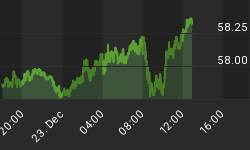Though Yogi never said it, we will: Look for 2005 in the stock market to be a year of three halves - up, down and sideways.
The implication for traders should be clear. Figure out which half will be up and get long. Short the half that will head south. And spread the sideways half. (As we've always told you, like gold, there's a place for options in everyone's portfolio!)
The long crowd will take heart in an improving economy, falling energy prices, upbeat investor sentiment since the election and the stock market's recent rally. Short-sellers will cite the sickly U.S. dollar, bloated consumer debt, rising interest rates and the current account problems. To the sideways group confusion will reign and each of the above will nullify the other.
One caveat about the sideways prediction is in 2004 the market stayed range bound between 9,700 on the downside and 10,800 or so at the top. And markets rarely, perverse beasts that they are, give repeat performances. But then there is always a second caveat. Investors experienced a big bull market in the early 1960s.You need to recall that the stock market remained in a sideways funk from 1966 to 1982, with the Dow Jones Industrial Average trading roughly between 700 and 1,000. A lot of things happened in those 16 years, a president resigned in disgrace, a major war, two oil embargoes, runaway inflation and my pet aardvark Prudence eloped to Las Vegas one starless night with the neighbor's pachyderm, to name some. What was a 300 point spread then may be a 1,000 point spread today. Call it progress. Just don't claim, like all those cigarette smokers who sued tobacco companies, no one warned you. The warning is always on the label: "Wash this garment in cold water and tumble dry. Cool iron if necessary."
So maybe for 2005 you need to create your own hedge fund. Surely you have heard of them; pension funds have and thousands are now floating about. There are even hedge funds for hedge funds. What's another one or two? In simple terms, you might want to purchase a long-dated call and a long-dated put on the market. In the vernacular of the option world, it's called a straddle. And just to be safe (remember in the name of common decency you have to cover all those exposed areas) you might want to buy a bull call spread, a bear call spread, a bull put spread and a bear put spread. And for good measure toss in a diagonal or butterfly spread here and there and you just might get it right.
Or you could do what the institutional crowd wants and take the pusillanimous path. Confuse the market completely: buy and hold. After all they will tell you the market has an upward historical bias. And they are not chary about regurgitating the data to prove it. Indeed, the market does have an upward bias. But much depends on when you buy the ticket and where you decide to get on board or, to put it differently, who is selecting the bias.
Yogi said if you see a fork in the road take it. We prefer three halves.
IN SURVEYS WE TRUST
Question: What do you get when you conduct a survey?
Answer: It depends on where you conduct it and what you're looking for. If you're thinking exit polls here, you're not far a field.
If it's euphoria you're seeking and you've been nosing lately around Wall Street, you've come to the right place. According to a recent Barron's article, the latest report from Investors Intelligence, a firm that tracks stock market sentiment of advisors, shows 62 percent are bullish on the market. That's the highest bullish reading since 1987, a year old-timers will recall that started well but ended ugly.
For those unfamiliar with sentiment surveys, they're usually considered contrarian indicators. In other words, when investor spirits are high the market is close to reversing or topping out. In short, a 62 percent bullish reading suggests that advisors and professional money managers now view caution like Margaret Mitchell's classic epic Gone With the Wind.
Read the following sentence (italics are ours) twice out loud for another way to get a grip on sentiment indicators. The market never accommodates what the masses desire! The market never accommodates what the masses desire! And in our definition of the masses we include central bankers. To see how individual retail investors feel, let's look at (you guessed it) another survey.
Boston mutual fund company Eaton Vance recently commissioned a survey of 1,000 investors. Fifty-nine percent described themselves as bulls. But the real kicker was 40 percent expected within 3 to 5 years a repeat performance of the heat-seeking missile market of the late 1990s. And 9 percent expected the big bull's return sooner. We won't even trouble you with what sector they thought would lead the charge. That's what academics call a given.
For still another view of investor bullishness or optimism check out the put call ratio. Again, according to Barron's, in the first two weeks of December investors at the International Security Exchange purchased more than two call options to every put option. And the 10-day moving average for call-buying to put-buying moved to 2.27 from 1.5 pre-election. The implication should be clear: bullish investor sentiment has pulled the stock market along with it. In case you have not heard that big sigh of relief, brokerage firms are likewise reporting an up-tick in trading volume.
So, as they say, the ducks are pretty much lined up. All we need now is another survey to tell us where and when they will stop quacking and start pooping.
















